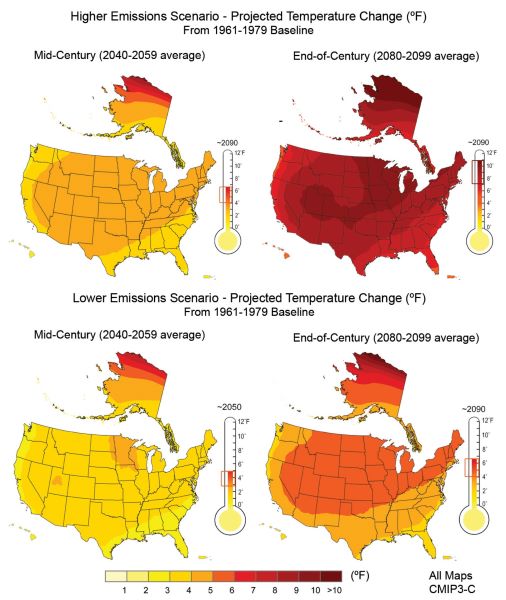

Scientists use computer models of the climate system to better understand and project future climate changes.

Curated/Reviewed by Matthew A. McIntosh
Public Historian
Brewminate
Increasing Greenhouse Gas Concentrations
Overview
Greenhouse gas concentrations in the atmosphere will continue to increase unless the billions of tons of our annual emissions decrease substantially. Increased concentrations are expected to:
- Increase Earth’s average temperature
- Influence the patterns and amounts of precipitation
- Reduce ice and snow cover, as well as permafrost
- Raise sea level
- Increase the acidity of the oceans
- Increase the frequency, intensity, and/or duration of extreme events
- Shift ecosystem characteristics
- Increase threats to human health
These changes will impact our food supply, water resources, infrastructure, ecosystems, and even our own health.[1]
Future Changes Will Depend on Many Factors
- NRC Climate Stabilization Targets increase in greenhouse gas concentrations
- Natural influences on climate (e.g., from volcanic activity and changes in the sun’s intensity) and natural processes within the climate system (e.g., changes in ocean circulation patterns)
Scientists use computer models of the climate system to better understand these issues and project future climate changes.
Past and Present-Day Greenhouse Gas Emissions Have Long-Reaching Effects

Many greenhouse gases stay in the atmosphere for long periods of time. As a result, even if emissions stopped increasing, atmospheric greenhouse gas concentrations would continue to increase and remain elevated for hundreds of years. Moreover, if we stabilized concentrations and the composition of today’s atmosphere remained steady (which would require a dramatic reduction in current greenhouse gas emissions), surface air temperatures would continue to warm. This is because the oceans, which store heat, take many decades to fully respond to higher greenhouse gas concentrations. The ocean’s response to higher greenhouse gas concentrations and higher temperatures will continue to impact climate over the next several decades to hundreds of years.[2]
To learn more about greenhouse gases, please visit the Greenhouse Gas Emissions page and the Greenhouse Effect section of the Causes of Climate Change page.
Because it is difficult to project far-off future emissions and other human factors that influence climate, scientists use a range of scenarios using various assumptions about future economic, social, technological, and environmental conditions.
Future Temperature Changes
Overview
We have already observed global warming over the last several decades. Future temperatures are expected to change further. Climate models project the following key temperature-related changes.
Key Global Projections


- Increases in average global temperatures are expected to be within the range of 0.5°F to 8.6°F by 2100, with a likely increase of at least 2.7°F for all scenarios except the one representing the most aggressive mitigation of greenhouse gas emissions.[2]
- Except under the most aggressive mitigation scenario studied, global average temperature is expected to warm at least twice as much in the next 100 years as it has during the last 100 years.[2]
- Ground-level air temperatures are expected to continue to warm more rapidly over land than oceans.[2]
- Some parts of the world are projected to see larger temperature increases than the global average.[2]
Key U.S. Projections

- By 2100, the average U.S. temperature is projected to increase by about 3°F to 12°F, depending on emissions scenario and climate model.[1]
- An increase in average temperatures worldwide implies more frequent and intense extreme heat events, or heat waves. The number of days with high temperatures above 90°F is expected to increase throughout the United States, especially toward the end of the century.[1] Climate models project that if global emissions of greenhouse gases continue to grow, summertime temperatures in the United States that ranked among the hottest 5% in 1950-1979 will occur at least 70% of the time by 2035-2064.[1]
Future Precipitation and Storm Events
Overview

Patterns of precipitation and storm events, including both rain and snowfall are also likely to change. However, some of these changes are less certain than the changes associated with temperature. Projections show that future precipitation and storm changes will vary by season and region. Some regions may have less precipitation, some may have more precipitation, and some may have little or no change. The amount of rain falling in heavy precipitation events is likely to increase in most regions, while storm tracks are projected to shift poleward.[2] Climate models project the following precipitation and storm changes.
Key Global Projections
- Global average annual precipitation through the end of the century is expected to increase, although changes in the amount and intensity of precipitation will vary significantly by region.[2]
- The intensity of precipitation events will likely increase on average. This will be particularly pronounced in tropical and high-latitude regions, which are also expected to experience overall increases in precipitation.[2]
- The strength of the winds associated with tropical storms is likely to increase. The amount of precipitation falling in tropical storms is also likely to increase.[2]
- Annual average precipitation is projected to increase in some areas and decrease in others. The figure to the right shows projected regional differences in precipitation under two emission scenarios.[2]
Key U.S. Projections

- Northern areas are projected to become wetter, especially in the winter and spring. Southern areas, especially the Southwest, are projected to become drier.[1]
- Heavy precipitation events will likely be more frequent, even in areas where total precipitation is projected to decrease. Heavy downpours that currently occur about once every 20 years are projected to occur between twice and five times as frequently by 2100, depending on location.[1]
- The proportion of precipitation falling as rain rather than snow is expected to increase, except in far northern areas.[1]
- The intensity of Atlantic hurricanes is likely to increase as the ocean warms. Climate models project an increase in the number of the strongest (Category 4 and 5) hurricanes, as well as greater rainfall rates in hurricanes.[1] There is less confidence in projections of the frequency of hurricanes.[1]
- Cold-season storm tracks are expected to continue to shift northward. The strongest cold-season storms are projected to become stronger and more frequent.[1]
Future Ice, Snowpack, and Permafrost
Overview
Arctic sea ice is already declining.[2] The area of snow cover in the Northern Hemisphere has decreased since about 1970.[2] Permafrost temperatures in Alaska and much of the Arctic [2] have increased over the last century.[1] To learn more about recent changes in snow and ice, visit the Snow and Ice page of the Indicators section.
Over the next century, it is expected that sea ice will continue to decline, glaciers will continue to shrink, snow cover will continue to decrease, and permafrost will continue to thaw. Potential changes to ice, snow, and permafrost are described below.
Key Global Projections

- For every 2°F of warming, models project about a 15% decrease in the extent of annually averaged Arctic sea ice and a 25% decrease in the area covered by Arctic sea ice at the end of summer (September).[3] Note that this decrease does not contribute to sea level rise.
- The coastal sections of the Greenland and Antarctic ice sheets are expected to continue to melt or slide into the ocean. If the rate of this ice melting increases in the 21st century, the ice sheets could add significantly to global sea level rise.[3]
- Glaciers are expected to continue to decrease in size. The rate of melting is expected to continue to increase, which will contribute to sea level rise.[3]
Key U.S. Projections
- Northern Hemisphere snow cover is expected to decrease by approximately 15% by 2100.[3]
- Models project the snow season will continue to shorten, with snow accumulation beginning later and melting starting earlier. Snowpack is expected to decrease in many regions.[3]
- Permafrost is expected to continue to thaw in northern latitudes, damaging buildings, infrastructure, and ecosystems in Alaska.[3]
Future Sea Level Change
Warming temperatures contribute to sea level rise by: expanding ocean water; melting mountain glaciers and ice caps; and causing portions of the Greenland and Antarctic ice sheets to melt or flow into the ocean.[3]
Since 1870, global sea level has risen by about 7.5 inches.[2] Estimates of future sea level rise vary for different regions, but global sea level for the next century is expected to rise at a greater rate than during the past 50 years.[2] Studies project global sea level to rise by another 1 to 4 feet by 2100, with an uncertainty range of 0.66 to 6.6 feet.[1]
The contribution of thermal expansion, ice caps, and small glaciers to sea level rise is relatively well studied, but the impacts of climate change on ice sheets in Greenland and Antarctica are less understood and represent an active area of research. Changes in ice sheets are currently expected to account for 1.2 to 8 inches of sea level rise by the end of this century.[3]

Regional and local factors will influence future relative sea level rise for specific coastlines around the world. For example, relative sea level rise depends on land elevation changes that occur as a result of subsidence (sinking) or uplift (rising). Assuming that these historical geological forces continue, a 2-foot rise in global sea level by 2100 would result in the following relative sea level rise:[4]
- 2.3 feet at New York City
- 2.9 feet at Hampton Roads, Virginia
- 3.5 feet at Galveston, Texas
- 1 foot at Neah Bay in Washington state
Relative sea level rise also depends on local changes in currents, winds, salinity, and water temperatures, as well as proximity to thinning ice sheets.[2]
Future Ocean Acidification

Ocean acidification adversely affects many marine species, including plankton, mollusks, shellfish, and corals. As ocean acidification increases, the availability of calcium carbonate will decline. Calcium carbonate is a key building block for the shells and skeletons of many marine organisms. If atmospheric CO2 concentrations double, coral calcification rates are projected to decline by more than 30%. If CO2 concentrations continue to rise at their current rate, the combination of climate warming and ocean acidification could slow coral growth by nearly 50% by 2050.[5]
Endnotes
- USGCRP (2014) Melillo, Jerry M., Terese (T.C.) Richmond, and Gary W. Yohe, Eds., 2014: Climate Change Impacts in the United States: The Third National Climate Assessment. U.S. Global Change Research Program.
- IPCC (2013). Climate Change 2013: The Physical Science Basis EXIT. Contribution of Working Group I to the Fifth Assessment Report of the Intergovernmental Panel on Climate Change [Stocker, T.F., D. Qin, G.-K. Plattner, M. Tignor, S.K. Allen, J. Boschung, A. Nauels, Y. Xia, V. Bex and P.M. Midgley (eds.)]. Cambridge University Press, Cambridge, United Kingdom and New York, NY, USA.
- NRC (2011). Climate Stabilization Targets: Emissions, Concentrations, and Impacts over Decades to Millennia EXIT. National Research Council. The National Academies Press, Washington, DC, USA.
- USGCRP (2009). Global Climate Change Impacts in the United States. Thomas R. Karl, Jerry M. Melillo, and Thomas C. Peterson (eds.). United States Global Change Research Program. Cambridge University Press, New York, NY, USA.
- IPCC (2014). Climate Change 2014: Impacts, Adaptation, and Vulnerability.
Originally published by the United States Environmental Protection Agency to the public domain.






